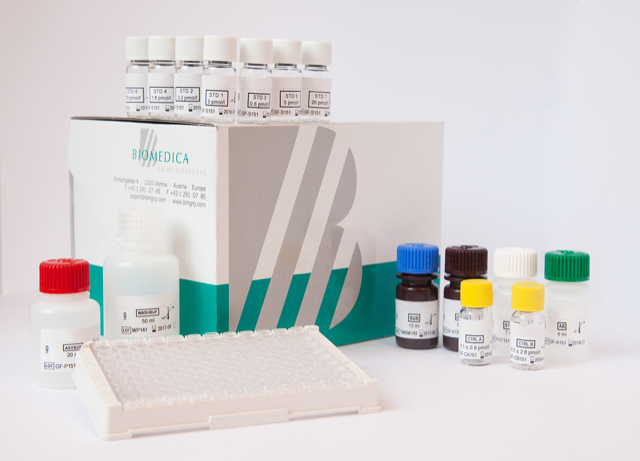LRG ELISA Assay Kit
LRG ELISA Assay Kit Developed and Manufactured in Austria by Biomedica
Size: 1×96 wells
Sensitivity: 0.26 ng/ml
Standard Range: 0 – 64 ng/ml
Incubation Time: 3.5 hours
Sample Type: Serum, Plasma
Sample Size: 100 µl pre-diluted sample / well (5 µl sample)
Alternative Names: LEUCINE-RICH ALPHA-2-GLYCOPROTEIN
For Research Use Only
Controls Included
Assay Principle
The LRG (leucine-rich alpha-2-glycoprotein) ELISA is a sandwich enzyme immunoassay for the quantitative determination of LRG in human serum and plasma samples. Samples must be pre-diluted 1:4000 prior to assaying, see chapter 5) Reagent and Sample Preparation. Standards and controls are used undiluted.
In a first step, standards, controls and pre-diluted samples are pipetted into the wells of the microtiter strips, which are pre-coated with polyclonal sheep anti-human LRG antibody. LRG present in the standard/control/sample binds to the pre-coated antibody in the well. All non-specific unbound material is removed in a washing step and the detection antibody (CONJ, polyclonal sheep anti-LRG-HRPO) is pipetted into the wells. After another washing step, the substrate (TMB, tetramethylbenzidine) is added. The enzyme-catalyzed color change of the substrate is directly proportional to the amount of LRG present in the sample. This color change is detectable with a standard microplate reader. A dose response curve of the absorbance (optical density, OD at 450 nm) using the values obtained from the standards versus the standard concentration is generated.
The concentration of LRG in the sample is determined from the dose response curve. This sample concentration must be multiplied by the dilution factor used for sample preparation to obtain final sample concentration (e.g. if dilution factor is 1:4000 the concentration obtained from the response curve must be multiplied by 4000).
Related Products
BNP Fragment ELISA Kit
Big Endothelin-1 ELISA Assay
Periostin ELISA Assay Kit
Assay Background
LRG (leucine-rich alpha-2-glycoprotein) is a glycoprotein with a molecular mass of 38.2 kDa. It is encoded by the human gene LRG-1 which is mapped on chromosome 19 at the cytogenetic band 19p13.3. The protein LRG (or also named LRG1) runs at approximately 50 kDa under reducing conditions, as it contains a carbohydrate content of 23% (1). LRG is the founding member of the family of leucine-rich repeat proteins (2). The mature protein consists of 312 amino acids, from Val36 to Gln347, with a leucine content of 66 amino acids. LRG is folded to eight leucine-rich repeat (LRR) domains of 22 amino acid length, and a C-terminal LRRCT domain with 49 amino acid length (3). Human LRG shows 62.5% sequence identity with mouse LRG, and 60.7% with rat LRG.
LRG binds to the TGFβ accessory receptor endoglin, and in the presence of TGFβ1 this leads to the induction of the TβRII-ALK1-Smad1/5/8 signaling pathway (4). TGFβ1 therefore promotes binding of LRG to the proangiogenic ALK1 but inhibits the interaction with angiostatic ALK5. Induced signaling leads to endothelial cell proliferation and blood vessel outgrowth (4).
Like many other family members of the leucine-rich repeat (LRR) family, LRG has multiple binding partners. LRG directly interacts with the mitochondrial electron transfer protein cytochrome c (5), whereas the physiological relevance of this interaction is not yet known. LRG further binds to TGFβ1, the most frequently expressed TGFβ isoform.
The tissue distribution of LRG varies, with high-level expression in the liver, lower expression in the heart, and minimal expression in spleen and lung (3). LRG is expressed during hematopoiesis. It plays a role in the innate immune system as it is upregulated during neutrophil differentiation; LRG is packed into peroxidase-negative granules of human neutrophils and then secreted upon activation to modulate the microenvironment (6, 7). Differential expression of LRG is further associated with certain carcinomas, neurodegenerative disease, aging or autoimmune disease. In addition, studies have demonstrated an association between cardiac remodeling (hypertrophy, fibrosis, abnormal vasculature, heart failure) and reduced expression of LRG (8, 9).
LRG is involved in cell proliferation and immune response, in cell migration, neovascularization and apoptosis (4, 10, 11). It is a proangiogenic factor which is involved in the regulation of the TGFβ signaling pathway. Up-regulation of LRG is described in response to acute phase response in hepatocytes (12).
LRG is potentially a biomarker for a variety of diseases e.g. as inflammatory biomarker for autoimmune diseases such as rheumatoid arthritis and inflammatory bowel disease (13, 14). Numerous groups have shown that LRG is increased in various immune-related diseases such as psoriasis (15), juvenile idiopathic arthritis (16), Kawasaki disease (17), appendicitis (18), and cancers (19-23), indicating that LRG elevation is not only limited to autoimmune diseases. In addition, LRG may serve as a biomarker for several other disease conditions such as heart failure (24), and diabetes-related complications (25, 26). Plasma Leucine-Rich α-2-Glycoprotein has also been demonstrated to predict cardiovascular disease risk in end-stage renal disease (27). Leucine-rich α-2-glycoprotein is highly expressed in the brain and it is possible to distinguish idiopathic normal pressure hydrocephalus (iNPH) from other neurodegenerative diseases such as Alzheimer disease by measuring LRG in cerebrospinal fluid (28, 29).
Package Inserts
Please note: All documents above are for reference use only and should not be used in place of the documents included with this physical product. If digital copies are needed, please contact us.


